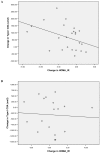Strength training improves muscle quality and insulin sensitivity in Hispanic older adults with type 2 diabetes
- PMID: 17211497
- PMCID: PMC1752232
- DOI: 10.7150/ijms.4.19
Strength training improves muscle quality and insulin sensitivity in Hispanic older adults with type 2 diabetes
Abstract
Hispanics are at increased risk of morbidity and mortality due to their high prevalence of diabetes and poor glycemic control. Strength training is the most effective lifestyle intervention to increase muscle mass but limited data is available in older adults with diabetes. We determined the influence of strength training on muscle quality (strength per unit of muscle mass), skeletal muscle fiber hypertrophy, and metabolic control including insulin resistance (Homeostasis Model Assessment -HOMA-IR), C-Reactive Protein (CRP), adiponectin and Free Fatty Acid (FFA) levels in Hispanic older adults. Sixty-two community-dwelling Hispanics (>55 y) with type 2 diabetes were randomized to 16 weeks of strength training plus standard care (ST group) or standard care alone (CON group). Skeletal muscle biopsies and biochemical measures were taken at baseline and 16 weeks. The ST group show improved muscle quality (mean+/-SE: 28+/-3) vs CON (-4+/-2, p<0.001) and increased type I (860+/-252 microm(2)) and type II fiber cross-sectional area (720+/-285 microm(2)) compared to CON (type I: -164+/-290 microm(2), p=0.04; and type II: -130+/-336 microm(2), p=0.04). This was accompanied by reduced insulin resistance [ST: median (interquartile range) -0.7(3.6) vs CON: 0.8(3.8), p=0.05]; FFA (ST: -84+/-30 micromol/L vs CON: 149+/-48 micromol/L, p=0.02); and CRP [ST: -1.3(2.9) mg/L vs CON: 0.4(2.3) mg/L, p=0.05]. Serum adiponectin increased with ST [1.0(1.8) microg/mL] compared to CON [-1.2(2.2) microg/mL, p<0.001]. Strength training improved muscle quality and whole-body insulin sensitivity. Decreased inflammation and increased adiponectin levels were related with improved metabolic control. Further studies are needed to understand the mechanisms associated with these findings. However, these data show that strength training is an exercise modality to consider as an adjunct of standard of care in high risk populations with type 2 diabetes.
Conflict of interest statement
Conflict of Interests: The authors declare no conflict of interests.
Figures
Similar articles
-
Effects of heavy-load strength training during (neo-)adjuvant chemotherapy on muscle strength, muscle fiber size, myonuclei, and satellite cells in women with breast cancer.FASEB J. 2024 Jul 15;38(13):e23784. doi: 10.1096/fj.202400634R. FASEB J. 2024. PMID: 38953567 Clinical Trial.
-
The effects of aerobic, resistance, and combined exercise on metabolic control, inflammatory markers, adipocytokines, and muscle insulin signaling in patients with type 2 diabetes mellitus.Metabolism. 2011 Sep;60(9):1244-52. doi: 10.1016/j.metabol.2011.01.006. Epub 2011 Mar 4. Metabolism. 2011. PMID: 21377179 Clinical Trial.
-
Protein Supplementation Augments Muscle Fiber Hypertrophy but Does Not Modulate Satellite Cell Content During Prolonged Resistance-Type Exercise Training in Frail Elderly.J Am Med Dir Assoc. 2017 Jul 1;18(7):608-615. doi: 10.1016/j.jamda.2017.02.006. Epub 2017 Apr 1. J Am Med Dir Assoc. 2017. PMID: 28377156 Clinical Trial.
-
Insulin resistance with aging: effects of diet and exercise.Sports Med. 2000 Nov;30(5):327-46. doi: 10.2165/00007256-200030050-00002. Sports Med. 2000. PMID: 11103847 Review.
-
Endurance, interval sprint, and resistance exercise training: impact on microvascular dysfunction in type 2 diabetes.Am J Physiol Heart Circ Physiol. 2016 Feb 1;310(3):H337-50. doi: 10.1152/ajpheart.00440.2015. Epub 2015 Sep 25. Am J Physiol Heart Circ Physiol. 2016. PMID: 26408541 Free PMC article. Review.
Cited by
-
Effects of strength training and detraining on knee extensor strength, muscle volume and muscle quality in elderly women.Age (Dordr). 2013 Oct;35(5):1899-904. doi: 10.1007/s11357-012-9478-7. Epub 2012 Sep 27. Age (Dordr). 2013. PMID: 23014987 Free PMC article.
-
Efficiency of vibration exercise for glycemic control in type 2 diabetes patients.Int J Med Sci. 2007 May 31;4(3):159-63. doi: 10.7150/ijms.4.159. Int J Med Sci. 2007. PMID: 17554399 Free PMC article. Clinical Trial.
-
Comparison of combined aerobic and high-force eccentric resistance exercise with aerobic exercise only for people with type 2 diabetes mellitus.Phys Ther. 2008 Nov;88(11):1345-54. doi: 10.2522/ptj.20080124. Epub 2008 Sep 18. Phys Ther. 2008. PMID: 18801851 Free PMC article. Clinical Trial.
-
Cluster Sets to Prescribe Interval Resistance Training: A Potential Method to Optimise Resistance Training Safety, Feasibility and Efficacy in Cardiac Patients.Sports Med Open. 2023 Sep 19;9(1):86. doi: 10.1186/s40798-023-00634-z. Sports Med Open. 2023. PMID: 37725296 Free PMC article. Review.
-
Resistance Band Exercise Training Prevents the Progression of Metabolic Syndrome in Obese Postmenopausal Women.J Sports Sci Med. 2021 Mar 15;20(2):291-299. doi: 10.52082/jssm.2021.291. eCollection 2021 Jun. J Sports Sci Med. 2021. PMID: 34211322 Free PMC article. Clinical Trial.
References
-
- Zierath JR, Krook A, Wallberg-Henriksson H. Insulin action and insulin resistance in human skeletal muscle. Diabetologia. 2000;43:821–35. - PubMed
-
- Castaneda C, Bermudez OI, Tucker KL. Protein nutritional status and function are associated with type 2 diabetes in Hispanic elders. Am J Clin Nutr. 2000;72:89–95. - PubMed
-
- Wallberg-Henriksson H, Rincon J, Zierath JR. Exercise in the management of non-insulin-dependent diabetes mellitus. Sports Med. 1998;25:25–35. - PubMed
-
- Dutta C. Significance of sarcopenia in the elderly. J Nutr. 1997;127:992S–3S. - PubMed
Publication types
MeSH terms
Substances
Grants and funding
LinkOut - more resources
Full Text Sources
Medical
Research Materials
Miscellaneous


